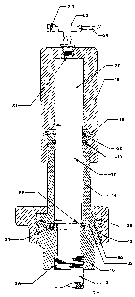Some of the information on this Web page has been provided by external sources. The Government of Canada is not responsible for the accuracy, reliability or currency of the information supplied by external sources. Users wishing to rely upon this information should consult directly with the source of the information. Content provided by external sources is not subject to official languages, privacy and accessibility requirements.
Any discrepancies in the text and image of the Claims and Abstract are due to differing posting times. Text of the Claims and Abstract are posted:
| (12) Patent: | (11) CA 1322379 |
|---|---|
| (21) Application Number: | 1322379 |
| (54) English Title: | HIGH PRESSURE ROD SEALING UNIT FOR FLUID PRESSURE GAUGES |
| (54) French Title: | JOINT DE TIGE HAUTE PRESSION POUR MANOMETRE |
| Status: | Expired and beyond the Period of Reversal |
| (51) International Patent Classification (IPC): |
|
|---|---|
| (72) Inventors : |
|
| (73) Owners : |
|
| (71) Applicants : |
|
| (74) Agent: | |
| (74) Associate agent: | |
| (45) Issued: | 1993-09-21 |
| (22) Filed Date: | 1988-07-18 |
| Availability of licence: | Yes |
| Dedicated to the Public: | N/A |
| (25) Language of filing: | English |
| Patent Cooperation Treaty (PCT): | No |
|---|
| (30) Application Priority Data: | None |
|---|
HIGH PRESSURE ROD SEALING UNIT FOR
FLUID PRESSURE GAUGES
-DAN VINH TRAN AND AMBROSE SHIU KI CHUN-
ABSTRACT
It is a common problem to devices which are used for segregating
the working fluids, such for example as the drilling mud fluid using in
drilling rig, from the pressure gauges, that the highly polished
cylindrical surfaces for piston sealing are damaged by the solids which
are carried by the working fluid. In this invention, a rod sealing
mechanism is used to eliminate the above problem. In addition, the
spare part which has to be replaced, if necessary, is far more
economical, that is, to replace the rod itself instead of the
internally-polished cylinder.
Note: Claims are shown in the official language in which they were submitted.
Note: Descriptions are shown in the official language in which they were submitted.

2024-08-01:As part of the Next Generation Patents (NGP) transition, the Canadian Patents Database (CPD) now contains a more detailed Event History, which replicates the Event Log of our new back-office solution.
Please note that "Inactive:" events refers to events no longer in use in our new back-office solution.
For a clearer understanding of the status of the application/patent presented on this page, the site Disclaimer , as well as the definitions for Patent , Event History , Maintenance Fee and Payment History should be consulted.
| Description | Date |
|---|---|
| Inactive: IPC from MCD | 2006-03-11 |
| Inactive: Adhoc Request Documented | 1996-09-21 |
| Time Limit for Reversal Expired | 1996-03-23 |
| Letter Sent | 1995-09-21 |
| Grant by Issuance | 1993-09-21 |
There is no abandonment history.
Note: Records showing the ownership history in alphabetical order.
| Current Owners on Record |
|---|
| DAN V. TRAN |
| AMBROSE S. K. CHUN |
| Past Owners on Record |
|---|
| None |